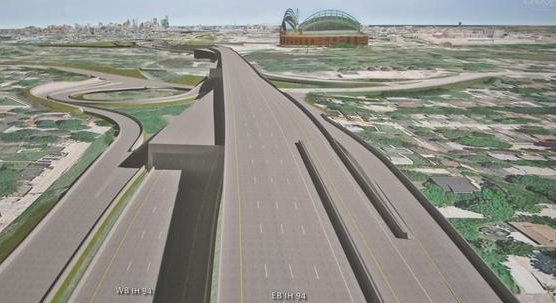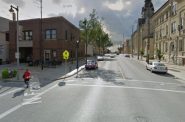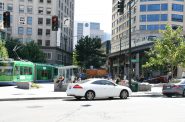Protesters Oppose Double-Decker Freeway
State wants either a double decker or 8-lane freeway through heart of city. Protestors demand different approach.

The Wisconsin Department of Transportation may spend a billion dollars to double-deck and expand a freeway in Milwaukee.
Last Monday night, as the Wisconsin DOT went through the motions of a Power Point presentation about the latest highway expansion it wants to gouge through Milwaukee, a group of protesters outside the meeting shouted their frustration with an agency that has spent lavishly on roads to the exclusion of all other modes.
The protesters’ message was simple. “Stop the highway.” Instead of sinking a billion dollars into another highway that won’t solve the region’s transportation problems, they called for different options: better transit, walking, and biking connections.
Right now, the state is only thinking about cramming more cars into the Milwaukee transportation network. Wisconsin has settled on two options for the Interstate 94 corridor, and both involved widening 3.5 miles of highway. The first proposal is an eight-lane at-grade freeway. The second and even more ridiculous option is a double-decker freeway. WisDOT put forward this latter design out of a desire to add lanes — to “manage congestion” — without having to unearth the graves of veterans in the cemetery surrounding the road. (As Jeramey Jannene has reported, Mayor Tom Barrett has asked Gov. Scott Walker to reject the double decker idea and Walker has said all options are on the table — except moving the graves.)
But the protesters, who represent a coalition of groups from around the state and Milwaukee, reject both of the alternatives. That’s why instead of attending the meeting on Monday, they were outside protesting. The Wisconsin Department of Transportation should go back to the drawing board, said Bruce Speight of the Wisconsin Public Interest Research Group, one of the organizing groups.
“We don’t need to expand the highway,” he said. “We need to give people real options.”
The same coalition, representing racial minorities in Wisconsin, recently settled in court with the state over the $1.7 billion “Zoo Interchange” project, which they alleged was discriminatory. After a judge issued an interim ruling in their favor, the groups agreed to a settlement that awarded $13.5 million in transit funding.
While that was an important win, $13.5 million is peanuts compared to what Wisconsin spends to move people faster in cars. Speight said the DOT’s billion-dollar proposal for I-94 is expected to save the average commuter just four minutes.
“They were talking about the need to probably widen it again in 25 years,” he said. “If we provide more and better options… we’ll actually solve the problem and give the people of Milwaukee better roads and transit options.”
“This is just an unnecessary, misguided, and wasteful project.”
Story by Angie Schmitt. A version of this story originally ran on Streetsblog. Angie Schmitt is a newspaper reporter-turned planner/advocate who manages the Streetsblog Network from glamorous Cleveland, Ohio. She also writes about urban issues particular to the industrial Midwest at Rustwire.com.
Streetsblog
-
Car Culture Cements Suburban Politics
![Sprawl. Photo by David Shankbone (David Shankbone) [GFDL (http://www.gnu.org/copyleft/fdl.html) or CC-BY-SA-3.0 (http://creativecommons.org/licenses/by-sa/3.0/)], via Wikimedia Commons [ https://commons.wikimedia.org/wiki/File%3ASuburbia_by_David_Shankbone.jpg ]](https://urbanmilwaukee.com/wp-content/uploads/2017/10/1024px-Suburbia_by_David_Shankbone-185x122.jpg) Nov 23rd, 2018 by Angie Schmitt
Nov 23rd, 2018 by Angie Schmitt
-
Most Drivers Don’t Yield to Pedestrians
 Mar 22nd, 2018 by Angie Schmitt
Mar 22nd, 2018 by Angie Schmitt
-
Jobs Up Yet Driving Down in Seattle
 Feb 22nd, 2018 by Angie Schmitt
Feb 22nd, 2018 by Angie Schmitt






















While I agree that the city needs better transportation options, leaving 94 as is will only exacerbate the daily congestion — usually stop-and-go traffic — in the Miller Park area. The congestion will only get worse with time, and “better transit, walking and biking connections” won’t solve the problem.
I live downtown and work in Waukesha; short of a train or bus to the door of my company, I’ll still need to use a car. ( The Goerkes Corner park-and-ride is a half mile from my work. I’m supposed to walk that, in the rain and snow, with no sidewalks?) Much of the traffic going westbound from downtown in the morning heads north or south on 45/894 or further west to the second-ring suburbs and beyond. These people aren’t just goimg to another part of the city.
Again, the push for more extensive mass transit in Milwaukee is admirable, but it ignores the reality of many city residents who must commute to the suburbs to work. Or, would you rather have them move out of the city?
A billion dollars for a freeway…
How much would it cost to put the freeway underground?
How much would a subway line cost? (Would you rather have streetcars or a subway? I would say subway.)
I agree, the MCTS is underfunded. However, the buses congest roads as well (esp. wisconsin ave). We need smarter routes and better TECHNOLOGY that other cities have had for almost a decade. We need to do a better job of making more one-way streets (such has returning Wells to being Eastbound only).
The Suburb vs City battle rages on.
This doesn’t need to be a zero-sum, all-or-nothing game. Agree wholeheartedly that we need drastic improvements to public transit and city roads, but the freeway system is also integral to any major city. If we want the 1 million+ suburbanites (largely coming from the north and west) to frequent our city, build it up, etc., as well as encourage out-of-town, out-of-state visitors, our freeways need to be top-notch.
Why everyone is so averse to working together in a city-suburb partnership, I will never understand.
First off, I think congestion pricing is in order. Face it, open road tolling needs to happen and with congestion pricing it would fund for keeping the stretch maintained while giving people more of a reason to think of alternative modes.
Rail transit would be the key role seeing as the tracks already exist to Waukesha next to the New Berlin trail. Bus rapid transit with dedicated lanes on Bluemound from Goerkes Corners to Downtown and from Menomonee Falls to Downtown would also be highly beneficial to alleviating traffic.
“Insanity: doing the same thing over and over again and expecting different results.”
– Albert Einstein
Lincolin (post 2), a subway can cost as much as $1 billion per lane mile. In NY City, the “Second Avenue Subway” is costing about $4.5 billion for its first 1.5-mile, 2-track (2-lane) segment. And, unlike automobiles, electric subway trains don’t produce toxic exhaust fumes; a highway tunnel would also have the extra cost of constructing a ventilation system to remove the fumes and bring in fresh air.
First of all, Lincoln is wrong about one way streets. Get rid of them! The last thing we need are freeways through downtown. They kill retail, make cities less walkable and create a danger for pedestrians and bikers. Farwell Avenue comes to mind. Fortunately the City agrees and one by one, they’re going away. Secondly, we cannot continue to make the mistake of designing our cities primarily for the car. we learned that lesson in the 60s and 70s. Milwaukee has one of the easiest commutes in the country for a city its size. A major reason for that is a relativly dense county and metro area as well as excellent secondary roads like Wisconsin, North, National, etc. Due to the our density, these corridors are viable.
The DOT gets very little scrutiny. We argue about pennies in this state, but if the DOT wants to spend billions on projects that are arguably not necessary, we don’t question anything. God forbid we want a bike path or improved transit, we’re called Communists and Socialists. Sadly, this like every other issue in our region is partisan. The double decker freeway may be the dumbest idea to come out of state government since the Park East freeway.
David (post 7), I know that one-way streets are supposed to be bad urban design, but I don’t see it that way. It is far easier to walk across a one-way street: You only need look one way and because there are always breaks in traffic every minute or so (corresponding to the “upstream” traffic signal).
Midtown Manhattan is about 95% one-way streets and, despite heavy traffic, it is one of the easiest places for pedestrians to cross streets.
One-way streets only become pedestrian hazards when vehicles speed, and that is easily controlled with timed traffic signals (like Madison does today on Johnson/Gorham/University).
It’s just amazing to me that DOT has no clue that transportation as an English word means anything except moving people (and actually usually “a person”) by automobile. Recognizing that little if any money is contributed to the campaign coffers of Wisconsin Politicians by those who ride buses or trains, it still seems so shortsighted by all involved not to look around at places like Phoenix, Portland, Chicago, New York City, and other “modern” metropolises and see their transportation SYSTEMS! What is so hard to understand that Chicago and Illinois use rail and streets to move people in and out of the city or that Kenosha and Pleasant Prairie housing is being gobbled up by RAIL commuters from the Chicago area! And these DOT folks are supposed to be people who plan for the future of the Metropolitan area?? Isn’t it time to stop building freeways and start building the other “legs” of a transportation system?
One clarification to my prior post (number 8):
When I said it was easy to cross streets in Manhattan, I wasn’t talking about crossing at corners (all of which have traffic signals in Manhattan); I was talking about crossing mid-block without signals (which is illegal, but most Manhattanites do it anyway because it is so easy).
It is fairly easy to cross Farwell or Prospect today–just wait for the guaranteed pause in traffic caused by the “upstream” traffic signal. If those streets were two-way, the chances of north-bound and south-bound traffic gaps coinciding would be slim.
I can’t remember the last time I was stuck in traffic on Wells Street or any other street downtown with the exception of minor congestion on Wisconsin Ave or Water. Cars fly down Wells, now they can do it in both directions.Two way traffic slows speeds and allows for a better pedestrian experience, which leads to a lively environment and hopefully more development. Just look at how dead the one ways are in the city vs. the two way streets. I don’t see the need. Cars will speed whether there are controlled lights or not. In addition, umarked crosswalks are extremely dangerous with one way traffic because cars simply go around the car in front of them not seeing the pedestrian. I live that everday on the Eastside along Farwell. Cars race to that next stop light. Its just my opinion.Blocks are too long for controlled lights to have a huge impact.
I believe that cars will find their way and the priority should be placed on the pedestrian, biker and transit user, at least within our densley populated city neighorhoods.
Regardless of my feelings on adding lanes to I94, why on earth are they building the second lane on top of what exists there now? They should just set the lower level below grade, and keep the upper level at the same level as the current roadway.
Continually disappointed in Angie’s writing regarding transportation and highway construction. The standards of fact checking or even journalistic integrity seem below Urban Milwaukee’s standards.
For example, where do we get this billion dollar figure for rebuilding I-94? The double decker option was the expensive option at $310 million. The at grade option was a third of that.
@Andy
http://www.bizjournals.com/milwaukee/news/2013/07/30/stadium-interchange-proposal-calls-for.html?page=all
“The Stadium Interchange reconstruction could cost anywhere from $810 million to $1 billion, depending on whether one segment is rebuilt at-grade or as a two-level double-decker freeway.” Sean Ryan Business Journal.
@Andy I will tweak to say $1 billion for the double deck and freeway expansion.
This disaster of a proposal has the appearance of DOT’s Icarus moment. My goodness. At what point does common sense emerge and DOT finally start working on a transportation “system”?
Meanwhile, other cities will continue to learn from past mistakes and build livable places that have transportation options within a coherent, easy to use network. And our best, brightest, most innovative young talent will continue to move to those places.
Dave… Fair enough.
Is there a way to register comments/complaints to the DOT on these proposals?
I’m not a fan of highways at all but I think “Hereiam” above has suggested the rudiments of a possible win win solution for all if walker’s dot can stop trying to be a period.
If it is somehow found out to be absolutely necessary to build another lane to I94 the new section should, indeed, be built underground with the original above grade section redesigned to accommodate development underneath itself, opening up a huge amount of possible park space and real estate like Boston’s Big Dig without all the complexities of that project, like historical preservation and infrastructure relocation.
That scenario would be dot trying to be a complete sentence, if they want to attempt to be an entire paragraph, for once, and really do something to benefit all of Wisconsin (instead of just walker’s campaign donors they working for now) they would make infrastructure preparations for a rail link between the imagined below grade and above grade lanes.
If the valley is the perfect place for a highway it likewise is the perfect place for a new regional rail system that can then be built out into the city and the inner and outer suburbs like neurons radiating from a spinal chord.
Something like that needs to be our future reality.
For the sake of Milwaukee and, whether they like it or not, the rest of Wisconsin- we must find a way to do it. We’re not going to let our great state turn even more into the Mississippi of the north.
Also, Urban Milwaukee, when can we get an ‘edit’ feature so I can preempt the grammar cops when I’m posting on the go? lol
I’m just guessing, but I would imagine the cost of putting the lower deck below grade would be quite a bit more expensive. The extra cost comes not just from the dig, but imagine all the underground infrastructure that would need to be modified.
Let’s get creative to solve this: public transport (many options here), bike lanes, carpool lanes, motorcycle lanes, encourage “slugs,” encourage flexible work schedules, etc. I’d like to see an article that expresses: 1) What is the true problem here? 2) When is it occurring? 3) How many people have this problem? 4) How long is an “average” commute? Savings 4 minutes is what percent of the total? 5) What are the alternatives to fix this undefined problem other than a free way?
I think if there is a will, the DOT will find a way to make the segment safer and add a lane. We all know the DOT and the road builders would like nothing more than double decking the freeway, but it’s so expensive and the maintenance on elevated roads is a lot costlier. It would be very disruptive. I travel between Milwaukee and HWY 100 daily and its very manageable.
I’ve lived in Chicago. I lived outside Philly while working in Philadelphia. I lived in North Jersey while working in Manhattan. Needless to say, the traffic here in no way comes close to being as wide-ranging and time-consuming as the traffic in Chicago, Philly, or NYC. I agree with people when they say that we can’t allow existing roads/highways to crumble and fall apart. But that isn’t the same thing as spending hundreds of millions of dollars to add new lanes/roads or a double-decker freeway or whatever. Is the congestion really that big of a problem in the first place? And if it is, is the solution spending $800 million to add new lanes to 94? Or will that just lead to induced demand and not actually solve anything?
(I’m supposed to walk that, in the rain and snow, with no sidewalks?)
We could instead spend a tiny fraction of the proposed amount to improve pedestrian infrastructure and plowing (and at the same time save people the need to go to the gym to get their exercise…).
I get why moving graves is a big deal. But, at some point, doesn’t that have to be on the table when we’re talking hundreds of millions in additional expenses?
Also, I think DOT’s models are overestimating traffic growth and even with the same goals in mind we can save money with more realistic models. How many shopping trips have been saved over the years by Amazon, as noted by how brick and mortar retailers are struggling? In many ways, the smartphone and internet is changing lifestyles. Updating the models is probably the most cost effective solution that anyone could propose for the State.
Cassandra – “(I’m supposed to walk that, in the rain and snow, with no sidewalks?)”
No, no you’re not. No pedestrian or non-motorized vehicle is allowed on freeways except under very specific circumstances. Regardless of weather conditions.
Kyle, I think Jeff (post 1) was talking about walking along Blue Mound or Barker. Those roads are not freeways and do not prohibit pedestrians. But, without sidewalks, walking along one of these streets (especially after dark) would be almost suicidal.
Any workplace within a half mile of any transit stop (like Goerke’s Corners) should be safely accessable without a car. Sidewalks should be added next time the roads are rebuilt–the added cost would be minimal.
From Robert R: “I get why moving graves is a big deal. But, at some point, doesn’t that have to be on the table when we’re talking hundreds of millions in additional expenses?”
I agree 100%. The politicians need to grow a pair and put it on the table as one of the logical options.
I’ve always thought it was shameful as is anyways; only a concrete retaining wall, rusty chain link fence and few feet of dirt separate the freeway from what’s supposed to be a peaceful place. Moving some people might actually be the respectful thing to do.
I wonder what a survey of the families involved would reveal…
Why can’t the citizens of Milwaukee, and their Politicians realize how beneficial Toll Roads can be for the region? It appears that most of the drivers on this stretch of interstate are coming in from some of the most wealthiest suburbs in Metro Milwaukee, so why not build Toll Roads to help fund the roads for which they use the most? Like smokers, where cigarettes are highly taxed to discourage smoking, wouldn’t Toll Roads have the same effect on habitual drivers – AND produce the funds to maintain the current interstate system?